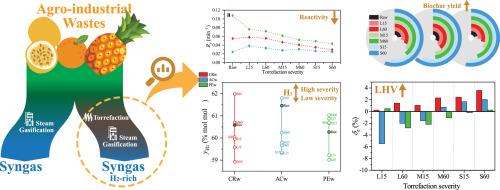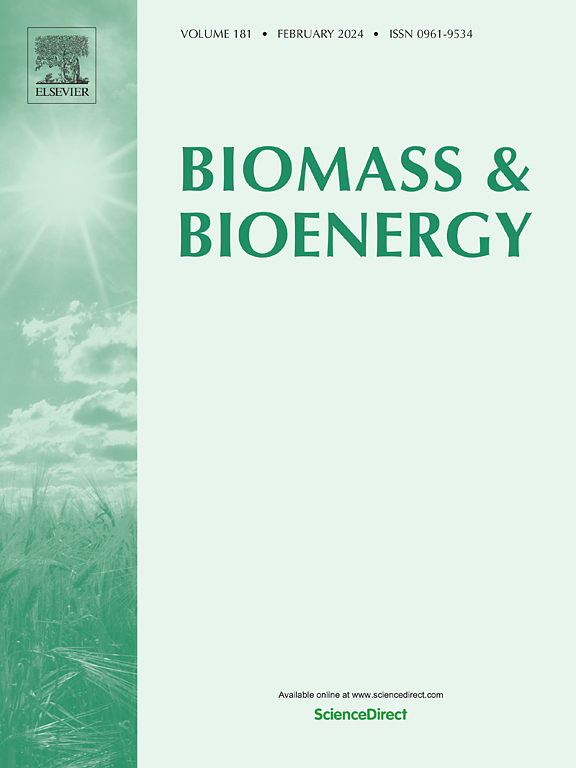Enhancing the potential for producing hydrogen-rich syngas through the steam gasification of low-value agro-industrial residues with torrefaction
IF 5.8
2区 生物学
Q1 AGRICULTURAL ENGINEERING
引用次数: 0
Abstract
Steam gasification is a highly effective method for producing hydrogen (H2) and represents a key valorization route for agro-industrial residues. In this scenario, the objective of the current study was to investigate the effect of torrefaction on the steam gasification of low-value agro-industrial residues, focusing on enhancing H2 content in syngas. Kinetic parameters were estimated, and syngas was quantified using macro-TGA/GC-TCD/FID. Torrefaction was performed under light (200 °C, 15–60 min), mild (250 °C, 15–60 min), and severe (300 °C, 15–60 min) conditions. The results revealed that torrefaction enhances H2 content in syngas, with the H2 molar fraction peaking at 62 % under severe conditions. Specifically, the H2 molar concentration increased across all severities except for passion fruit peel waste at severe conditions, where a decline was observed. Ponkan peel waste showed a consistent rise in H2 molar concentration at all torrefaction severities, with the most significant increase in the lower heating value of syngas. Additionally, torrefaction improved syngas composition by reducing the CO2 fraction and increasing the CO fraction, thus enhancing the overall lower heating value of the syngas. The kinetic study, utilizing the Modified Random Pore Model (MRPM), demonstrated precise fits and provided reliable predictions for the impact of torrefaction on steam gasification. The reduction in rate constants suggests improved surface reactions and greater structural stability in gasification kinetics. The findings from this study support the adoption of torrefaction as a promising pre-treatment method to optimize biochar properties and maximize hydrogen-rich syngas production from low-value agro-industrial residues.

通过蒸汽气化低价值农用工业残留物并进行高温分解,提高生产富氢合成气的潜力
蒸汽气化是一种生产氢气(H2)的高效方法,也是农用工业残留物的一条重要价值化途径。在这种情况下,本研究的目的是探究高温分解对低价值农用工业残留物蒸汽气化的影响,重点是提高合成气中的 H2 含量。研究估算了动力学参数,并使用宏观 TGA/GC-TCD/FID 对合成气进行了定量。在轻度(200 °C,15-60 分钟)、轻度(250 °C,15-60 分钟)和重度(300 °C,15-60 分钟)条件下进行了热解。结果表明,在苛刻条件下,高温分解可提高合成气中的 H2 含量,H2 摩尔分数最高可达 62%。具体而言,除了百香果果皮废料在苛刻条件下的 H2 摩尔浓度有所下降外,其他所有苛刻条件下的 H2 摩尔浓度都有所上升。椪柑果皮废料的 H2 摩尔浓度在所有热值条件下都持续上升,其中以合成气热值较低时升幅最大。此外,通过减少 CO2 部分和增加 CO 部分,高温分解可改善合成气成分,从而提高合成气的整体低热值。利用改良随机孔隙模型(MRPM)进行的动力学研究表明,托烷硫化对蒸汽气化的影响具有精确的拟合和可靠的预测。速率常数的降低表明气化动力学中的表面反应得到了改善,结构稳定性得到了提高。这项研究的结果支持采用高温分解作为一种有前途的预处理方法,以优化生物炭的特性,并最大限度地利用低价值农工业残留物生产富氢合成气。
本文章由计算机程序翻译,如有差异,请以英文原文为准。
求助全文
约1分钟内获得全文
求助全文
来源期刊

Biomass & Bioenergy
工程技术-能源与燃料
CiteScore
11.50
自引率
3.30%
发文量
258
审稿时长
60 days
期刊介绍:
Biomass & Bioenergy is an international journal publishing original research papers and short communications, review articles and case studies on biological resources, chemical and biological processes, and biomass products for new renewable sources of energy and materials.
The scope of the journal extends to the environmental, management and economic aspects of biomass and bioenergy.
Key areas covered by the journal:
• Biomass: sources, energy crop production processes, genetic improvements, composition. Please note that research on these biomass subjects must be linked directly to bioenergy generation.
• Biological Residues: residues/rests from agricultural production, forestry and plantations (palm, sugar etc), processing industries, and municipal sources (MSW). Papers on the use of biomass residues through innovative processes/technological novelty and/or consideration of feedstock/system sustainability (or unsustainability) are welcomed. However waste treatment processes and pollution control or mitigation which are only tangentially related to bioenergy are not in the scope of the journal, as they are more suited to publications in the environmental arena. Papers that describe conventional waste streams (ie well described in existing literature) that do not empirically address ''new'' added value from the process are not suitable for submission to the journal.
• Bioenergy Processes: fermentations, thermochemical conversions, liquid and gaseous fuels, and petrochemical substitutes
• Bioenergy Utilization: direct combustion, gasification, electricity production, chemical processes, and by-product remediation
• Biomass and the Environment: carbon cycle, the net energy efficiency of bioenergy systems, assessment of sustainability, and biodiversity issues.
 求助内容:
求助内容: 应助结果提醒方式:
应助结果提醒方式:


